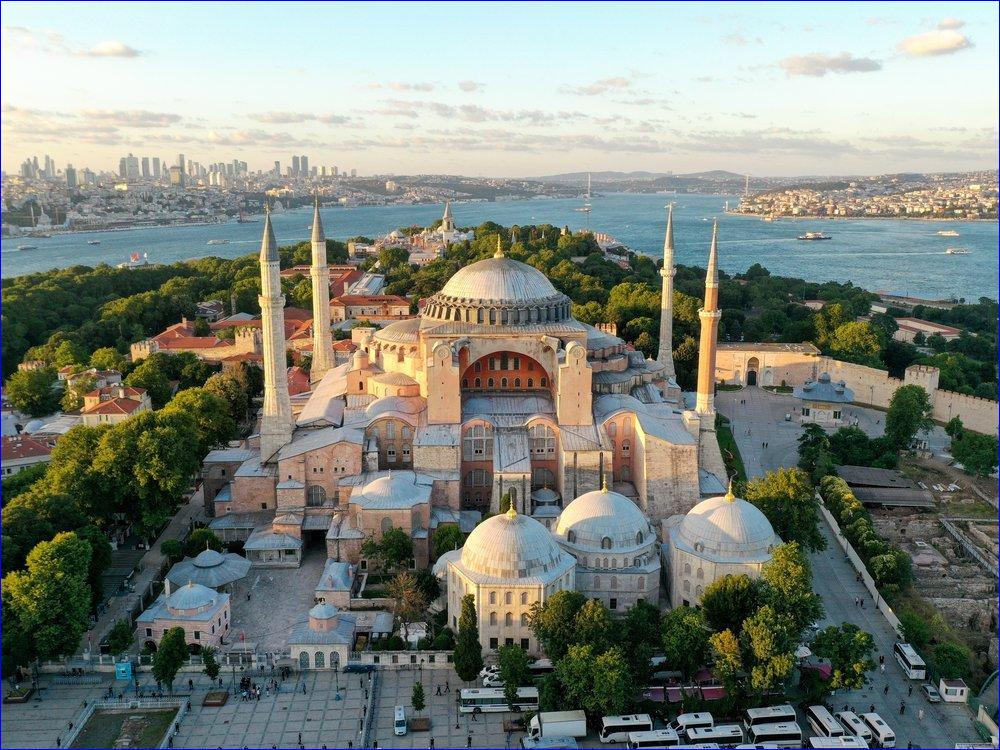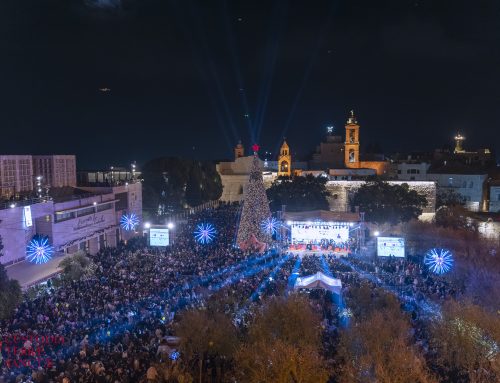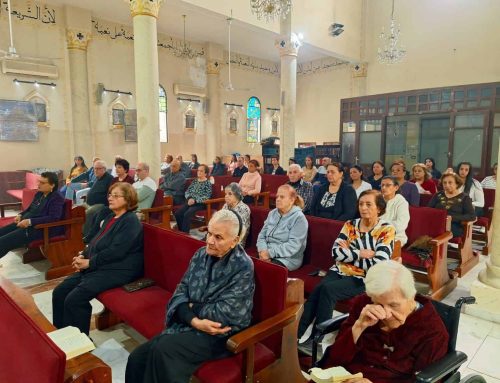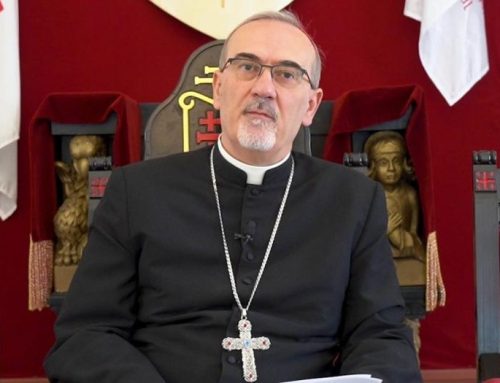In June 2021, Patriarch Sako shared a reflection on the difficulty of achieving unity among Christians, especially in Iraq. The differences among the churches are not only doctrinal, but also canonical and liturgical, geographic, ethnic, and linguistic. We strive to overcome doctrinal disagreements and some liturgical and canonical divergences, but these other factors are not intended to be overcome. Instead, they ought to remain with us and to be understood not as obstacles to our communion in faith and sacraments.
In response to His Beatitude, I proposed that consideration be given to a concrete outline of Christian unity that is compatible with our ancient differences. The most important aspect of unity that Christians seek is Eucharistic communion — the celebration of the Eucharist together. Few obstacles stand in the way of this. Although divided by schisms lasting even more than 1,500 years, Christians of the apostolic churches hope for and very well may see the restoration of communion among them in our own lifetimes.
After the restoration of Eucharistic communion will likely follow certain forms of administrative union. These may reflect liturgical, canonical, geographic, ethnic, linguistic, and other historical differences. Such administrative unions represent a unity far less important than Eucharistic communion. But they are quite concrete, and therefore they provide us with a somewhat more concrete vision of our future unity. In what follows, I’d like to reflect on the administrative shape of Christian unity, especially among the Syriac Churches.
At the start, I must limit the scope of my considerations to the four communions of apostolic churches, such as understood by the Catholic Church: Catholics, Eastern Orthodox, Oriental Orthodox, and the Assyrian and Ancient Churches of the East. Also, I am not anticipating a revolution in ecclesiology but will consider what lightest of administrative reforms might yield the clearest expression of Christian unity. Consequently, I begin with the observation that most Syriac-speaking Christians belong to three historic churches that date to apostolic times: the Church of Antioch, the Church of the East, and the Church of Malankara.
These historic churches are sadly divided among all four communions today — the Church of Antioch into five different patriarchates, the Church of the East into three (though hopefully soon to be two), and the Church of Malankara into six structures that remain within the four communions and several others in communion with Protestant Christians. The clearest expression of Christian unity through administrative reform would likely come from the restoration of unity within each of these three historic churches. In other words, the five patriarchates of Antioch would form a single Church of Antioch with one holy synod and one patriarch. The Assyrian and Chaldean churches would form a single Church of the East with one holy synod and one catholicos-patriarch. And the Syriac Churches of India would do the same.
Even after overcoming the outstanding doctrinal disagreements among the communions, several further divergences will need to be addressed in the case of each historic church. I’ll examine the case of each church one-by one.
The Church of the East
The situation with the Church of the East is likely the most straightforward. Both Assyrians and Chaldeans practice the East Syriac Rite and share much of their cultural heritage in common. Assyrians and Chaldeans list the sacraments differently, but the International Dialogue Commission between the Catholic Church and the Assyrian Church of the East has already indicated that this divergence is no obstacle to the restoration of communion. Assyrians and Chaldeans also count ecumenical councils differently, but one may hope that this and other issues of universal significance, such as how to reconcile divergent pastoral responses to failed marriages, will find similar resolution through the international dialogues.
However, consensus achieved at the international level that declares a divergence no obstacle to communion may not suffice for the administrative union of historically divided churches under one holy synod and one patriarch. So how the Church of the East will teach her faithful about the sacraments, about ecumenical councils, about the prerogatives of the Roman Pope, etc. will need to be worked out between Assyrians and Chaldeans specifically, in light of the consensus achieved by the international dialogue undertaken with Rome.
For the Church of the East, two issues will likely require special care: liturgical uniformity and ethnic identity. The East Syriac Rite has suffered some degree of Latinization among the Chaldeans. The Chaldean Church, especially under the leadership of Patriarch Sako, has also undertaken multiple liturgical reforms, even introducing the new Anaphora of St. Thomas. On the Assyrian side, the Assyrian Church of the East and the Ancient Church of the East continue to grapple with divergent calendars. Bringing all three patriarchates together will demand patience and flexibility from all, careful study of historical sources, especially in the correction of Latinizations, and, most likely, openness to some liturgical variation and to the good that each variant brings to the Church of the East in the service of her mission.
Ultimately, ethnic identity may not be an issue for the Church of the East. Some Chaldeans distinguish between an Assyrian ethnic identity and a Chaldean ecclesial identity and accept both. Others identify with a Chaldean ethnicity. Disagreements over ethnicity among Assyrians and Chaldeans and other partisans, and even over the nature of ethnic identity, have caused some tension. In ancient and medieval times, the Church of the East embraced many ethnicities throughout her canonical territory of Asia east of the Roman Empire. In the same way, the Church of the East need not in the future identify herself with any one ethnicity. I have proposed that the Church of the East adopt an ecclesiologically appropriate and non-ethnic appellation for her faithful: Eastern Apostolic, analogous to “Armenian Apostolic” and the less-used “Georgian Apostolic,” whose churches are also ancient catholicosates.
The Church of Antioch
The case of Antioch is more complex. Her faithful belong to five different patriarchates and practice three rites — Byzantine, Maronite, and West Syriac. Moreover, the Chalcedonian-Miaphysite schism that originally divided the Melkites and Maronites, on the one hand, from the Syriacs, on the other, has lasted for more than 15 centuries. Thankfully, this division has begun to heal.
Results of the Joint Commission of the Theological Dialogue between the Orthodox Church and the Oriental Orthodox Churches have found little reception. But the situation may soon change. In the wake of the recent decision by Patriarch Bartholomew of Constantinople to restore communion with and grant autocephaly to the faithful of the Orthodox Church of Ukraine and the partial schism and invasion of Ukraine by the Russian Federation that followed, the Orthodox Church has begun to retrieve an ancient understanding of oikonomia — not merely as lenience in pastoral care for individual souls but as a method to restore and preserve Christian unity. This retrieval may soon bear fruit for dialogue among all the apostolic churches.
Similar to the Church of the East, after consensus regarding issues of universal significance is achieved by the international dialogues and after the five patriarchates of Antioch have further refined this consensus for application within a single Church of Antioch, two more issues will likely require special care: how to handle liturgical diversity and Antioch’s canonical territory. Regarding the first, liturgical diversity will remain with Church of Antioch. Her faithful will not abandon their rites to adopt another or to blend them into one. Maybe each rite will undergo some adaptation to overcome incompatibilities among them or to draw them closer together. For example, the Maronites could correct Latinizations. Likewise, the Byzantines (today Antiochian Orthodox and Melkite Catholics) could give more prominence to the Anaphora of St. James. But each rite will persist.
Given such diversity, the Church of Antioch will need to consider how to preserve her unity. For example, she could retain three separate hierarchies that form one holy synod and that elect one patriarch, perhaps rotating the patriarchal office among the three rites. (The rotation could be simple or complex.) Alternatively, she could go further and integrate her dioceses around the world, so that each diocese has one pre-eminent bishop and additional auxiliary bishops of the other rites, according to needs of each diocese, who together serve the faithful. The pre-eminent episcopal office in each diocese might likewise rotate among the rites of the faithful in the diocese, unless tradition advises to the contrary — for example, the Archbishop of Mt. Lebanon should always be a Maronite. I don’t think that there are many mutli-rite dioceses at present, but the bi-ritual Archeparchy of Kottayam could serve as a model for tri-ritual dioceses in a united Church of Antioch.
Since 2009, the Orthodox Church has sought to integrate her diasporic jurisdictions around the world into 13 regional synods. If a united Church of Antioch sought to integrate her own Byzantine, Maronite, and Syriac jurisdictions around the world, the Antiochian Byzantine (Melkite) jurisdictions would forego integration with the other Byzantine jurisdictions in favor of integration with Maronites and Syriacs. Whether tri-ritual Antiochian jurisdictions in the US and Oceania would enjoy the same degree of autonomy that the Antiochian Orthodox jurisdictions have today would need to be determined by the united Church of Antioch. These proposals constitute just one strategy through which the Church of Antioch might address the liturgical diversity among her faithful.
To clarify Antioch’s canonical territory, it is best to begin with the territorial claims of the Greek Orthodox Church of Antioch, because she already enjoys communion with the neighboring churches of Constantinople and Jerusalem. In Turkey, Constantinople claims East Thrace and geographic Anatolia, while the Greek Orthodox Church of Antioch claims the territory from Cilicia through Turkish Kurdistan. (The Church of Georgia claims Turkey’s small Tao-Klarjeti region). Syria and Lebanon indisputably belong to Antioch, while Israel, Jordan, and Palestine belong to the Church of Jerusalem. In recent years, the Greek Orthodox Church of Jerusalem has supported a diocese in Qatar, despite the traditional assignment of the Arabian Peninsula to the canonical territory of Antioch.
The Greek Orthodox Church of Antioch also claims Iraq and Iran. However, these countries indisputably belong to the canonical territory of the Church of the East. Respect for the canonical territory of the latter need not entail the loss of Antioch’s dioceses in Iraq. The Church of the East could allow other churches to support local hierarchies to serve their faithful but insist that, within her canonical territory, Eastern Apostolic bishops enjoy precedence in relation to equally ranked bishops of other churches. Consequently, the Church of Antioch might support jurisdictions around the world but limit her territorial claims to Cilicia, Lebanon, Syria, Turkish Kurdistan, and the Arabian Peninsula.
(Relatedly, if the Armenian See of Cilicia ever accepts the status that the other major Armenian sees understand her to have — i.e. not as autocephalous but as an autonomous church under the authority of Etchmiadzin — and if, according to the desire of many Armenians in North America, Cilicia allows the duplicate Armenian jurisdictions that she supports there to integrate with the jurisdictions under the authority of Etchmiadzin (without thereby ceasing to support the Western Armenian traditions and historical memory preserved by the former), then Cilicia might claim jurisdiction over all and only Armenians within the canonical territories of Antioch and Cyprus. This would require Cilicia to surrender to Etchmiadzin the Armenian dioceses in Iran, and in turn for Etchmiadzin to surrender to Cilicia the Armenian jurisdictions in Damascus and the Arabian Peninsula.)
The Church of Malankara
Finally, we get to the case of the Church of Malankara. Like the Church of the East and unlike the Church of Antioch, this church suffered no lasting internal schism until the 16th century. Like the Church of Antioch and unlike the Church of the East, the faithful of this church are divided between different rites — East Syriac and West Syriac. And unlike either Antioch or the East, the Church of Malankara has never enjoyed an undisputed status of autocephaly (i.e. complete administrative independence).
Until the 16th century, the Church of Malankara belonged to the Church of the East. After the arrival of the Portuguese in India and their attempt to subjugate the Syriac-speaking Indian Christians to the Latin hierarchy and Latin Rite, the church split into those who preserved a Latinized version of the East Syriac Rite and became subordinate to Rome and those who adopted the West Syriac Rite and became subordinate to the Syriac Patriarch of Antioch. Since then, both communities have divided further, but all or nearly all parties have regained some autonomy, in different degrees, in relation to the Churches of Rome, Antioch, and the East. There have also been efforts to de-Latinize the East Syriac Rite in India.
Administratively, Christian unity might find the clearest expression among the Indian Christians of the Syriac Rites if they joined to form a single bi-ritual autocephalous church with one holy synod and one catholicos-patriarch. Tradition suggests a title for the latter such as follows: Catholicos-Patriarch of Kochi-Angamaly and Gate of All India. Malankara Christians already have experience with one bi-ritual diocese — the Archeparchy of Kottayam, which belongs to the Syro-Malabar Catholic Church and which serves the strictly endogamous subset of Malankara Christians called the Knanaya within the Catholic communion. A united Church of Malankara could integrate all her jurisdictions to form bi-ritual dioceses in India and worldwide, perhaps alternating the patriarchal and local episcopal offices between the rites, as I proposed for the Church of Antioch.
A rather recondite question remains regarding who would grant to the Church of Malankara the status of autocephaly. In the Catholic communion, only Rome can establish new patriarchates. In the Orthodox Church, Constantinople claims the sole right to grant autocephaly. The Church of Russia disputes this, as has the Church of Serbia in a somewhat half-hearted manner by her recent actions in relation to the Orthodox Church in North Macedonia. Among the Oriental Orthodox Churches, it seems that the church to whose territory the new church formerly belonged has this right. In this case of India, after the restoration of Eucharistic communion among the apostolic churches, it would seem most appropriate for the Churches of Rome, Antioch, and the East to act together to grant autocephaly to the Church of Malankara.
Such joint action would bring clarity to the situation. But at least one more significant administrative challenge remains. India is also home to several million Latin Catholics and several million Protestant Christians. Because the Latin Church has so significant a presence in the country, India could be treated as “shared canonical territory” — shared between the Church of Malankara and the Church of Rome — such that equally ranked bishops of the Syriac Rites and of the Latin Rite would have equal status. India is not the only country for which to consider the possibility of “shared canonical territory.” The Sinai Peninsula could be shared between the Churches of Alexandria and Jerusalem, the former caring for Alexandrian Rite faithful and the latter for Byzantine Rite faithful. And Central Europe — specifically Finland, Estonia, Latvia, Lithuania, Poland, Czechia, Slovakia, Hungary, Slovenia, Croatia, the Federation of Bosnia and Herzegovina, Montenegro, and Albania — could be shared between Rome, on the one hand, and Constantinople and her daughter churches, on the other.
Although making a territorial claim upon India, the Church of Rome could take other steps to support the autocephalous status of the Church of Malankara. For example, Rome could suppress the non-resident patriarchal title of the Latin Archbishop of Goa and either suppress the primatial title of the same archbishop or amend it with the addition of “for the Latins.” Rome also supports in India two national episcopal conferences: the Conference of Catholic Bishops of India (CCBI) for India’s Latin Rite bishops and the Catholic Bishops’ Conference of India (CBCI), which gathers all of India’s Catholic bishops and whose leadership rotates among the three rites. If not detrimental to India’s Latin Catholics, Rome could do away with the CCBI and propose that the presidency of the CBCI be assigned always to the Catholicos-Patriarch and the vice-president be elected by India’s Latin bishops. This would secure the ecclesiastical authority of the Church of Malankara in India.
For the sake of completeness, I will note that the Catholic Church also supports regional and continental “superconferences” — formally, “international meetings of bishops’ conferences.” Just as the presidency of the CBCI could be assigned to India’s Catholicos-Patriarch and its vice president be elected by India’s Latin bishops, so too could the presidency of Africa’s superconference (SECAM) someday be assigned to the Patriarch of Alexandria and its vice president be elected by all its bishops. Likewise might Asia’s superconference (FABC) someday include and its presidency be assigned to the Catholicos-Patriarch of the East and its vice president be elected by all its bishops. To Rome and Constantinople might be assigned, maybe in an honorary way, the presidency and vice presidency of Europe’s superconference (CCEE). Also in Europe, Rome could establish a regional superconference for Serbia, Kosovo, Montenegro, Bosnia, Croatia, and Slovenia, whose presidency might someday be assigned to the Patriarch of Serbia. Finally, because Cyprus, Ethiopia, Eritrea, and North Macedonia each have their own autocephalous churches, it would make sense for them to have their own episcopal conferences as well.
This discussion of the administrative shape of Christian unity in the Syriac Churches has been both very detailed and highly speculative. I have made some concrete proposals. However, my purpose is not to shape our future unity but to offer these speculations as an invitation to anticipate our future unity more concretely and consequently to desire it more fervently. Christ Himself prayed that we may be one. To the prophet Habakkuk, the Lord said: “Write the vision; make it plain upon tablets” and “Still the vision awaits its time; it hastens to the end — it will not lie. If it seems slow, wait for it; it will surely come, it will not delay” (Habakkuk 2:2-3).
By Benjamin Martin – AINA






